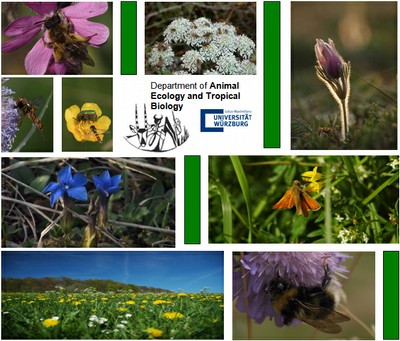Invertebrates II – Flower-visiting insects
In this subproject, we explore the specialisation of flowers and flower visitors on grasslands along a gradient of land use intensity. We focus on resource-based mechanisms that may determine flower visiting insect communities in different habitats.
Plant-flower-visitor interaction networks
Collection and identification of all flower-visitors as well as characterization of flower availability and composition on all grassland EPs of the exploratories.
Analysis of the degree of specialization/partitioning of interactions on three different levels:
(1) Individuals: analysis of flower constancy in individuals by means of pollen analysis; identification of pollen in faeces (e.g. from hoverflies)
(2) Population: specialization of each species in its local context
(3) Community: determination of network specialization
Availability and quality of resources
Analysis of nutrient composition in pollen (primarily amino acids)
- The individuals of a flower-visitor population differ concerning their flower preferences.
- The flower preference of an individual (individual specialization) depends on and changes with flower abundances.
- Flower abundances, composition and diversity are influenced by intensity of land use. Dependent on their degree of specialization flower-visitors are affected by these changes in resources.
- Flower availability and insect diversity are positively correlated.
- Visitation rate, visitor diversity and specialization increase with the amount and quality of pollen offered by a flower (mg pollen per flower plus composition of amino acids).
Given the global decrease in species diversity, the relationship between biodiversity of different taxa and levels and various ecosystem processes and services, such as pollination of many important crops by flower-visiting insects, gains more and more importance.
If, due to mutual specialization, flower-visitors are found to be highly dependent on flower diversity, this would mean that a decrease in flower diversity, known to be driven by agricultural intensification, would lead to parallel declines of both biodiversity and abundance of pollinators.
In this subproject we want to analyse the effect of land use intensity on diversity and specialization of plant-flower-visitor interactions. In this process we need to check firstly how dependent the different species are on each other. How high is the degree of specialization and how does the plant flower-visitor network react to external influences?
Plant-flower-visitor networks are very specialized in comparison to other plant-animal interactions. This is logical as it increases the probability of pollen being transferred among flowers of the same species instead of being wasted on alien flowers.
These analyses are important for the general understanding of ecosystems and their endangerment. If a bluebell species disappears from a grassland interaction network, does this mean a strong disruption? Or will insects just switch to other species if “their” plant suddenly disappears?
Along the land use gradient of the Biodiversity Exploratory plots we want to ascertain what effect land use intensity has upon plant-flower-visitor networks. Furthermore, we aim to identify the keystone species of variable interaction networks, in order to be able to make predictions for nature conservation.










